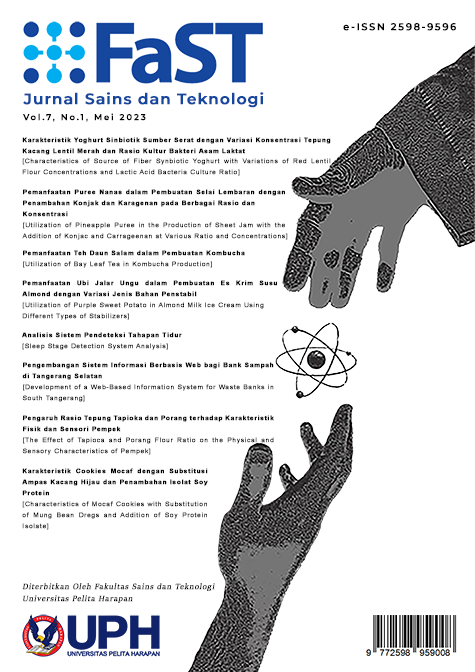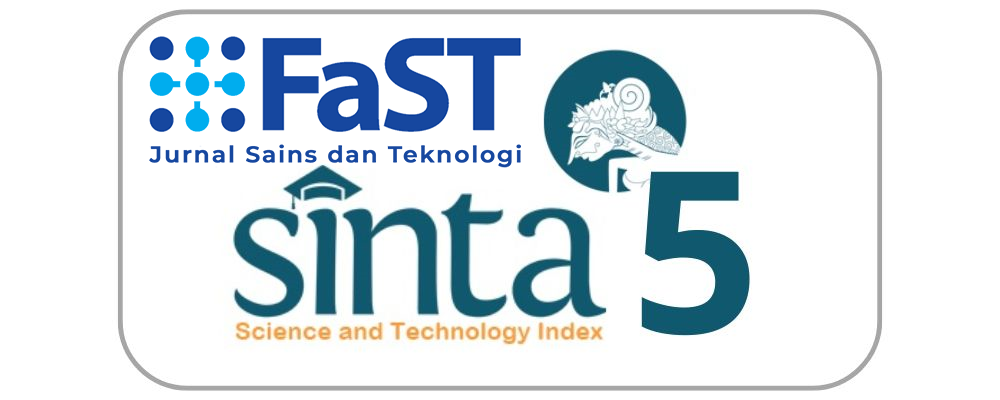PENGARUH RASIO TEPUNG TAPIOKA DAN PORANG TERHADAP KARAKTERISTIK FISIK DAN SENSORI PEMPEK [THE EFFECT OF TAPIOCA AND PORANG FLOUR RATIO ON THE PHYSICAL AND SENSORY CHARACTERISTICS OF PEMPEK]
DOI:
https://doi.org/10.19166/jstfast.v7i1.6737Keywords:
fish, porang, pempekAbstract
Porang tuber is one of Indonesia's local foods with high glucomannan content. Glucomannan is a type of soluble fiber that can strengthen myofibril gels which gives it potential usage in gel food such as pempek. This research is aimed to know the effect of the ratio between tapioca flour and porang flour (90:10, 80:20, dan 70:30) and concentration of fish (32.5%, 37.5%, dan 42.5%). The result showed that increasing fish concentration has a trend to also increase the springiness and scoring value of rubberiness. Increase in porang flour used cause pempek’s colour to change into more brown and lower lightness. The best formulations which is 42.5% fish concentration and tapioca flour:porang flour ratio of 90:10 has springiness of 0.92 ± 0.02, overall acceptance of 4.85 ± 1.26, moisture content of 67.32 ± 4.44%, and protein content of 5,10 ± 0,88%.
Bahasa Indonesia Abstract:
Umbi porang merupakan pangan lokal Indonesia yang memiliki kandungan glukomanan yang tinggi. Glukomanan merupakan serat larut yang dapat memperkuat gel miofibril sehingga dapat diaplikasikan pada produk olahan seperti pempek. Tujuan dari penelitian ini adalah untuk mengetahui pengaruh rasio tepung tapioka dan tepung porang (90:10, 80:20, dan 70:30) dan perbedaan konsentrasi ikan tenggiri (32,5%, 37,5%, dan 42,5%) terhadap karakteristik fisik dan sensori pempek lenjer. Hasil penelitian menunjukkan peningkatan konsentrasi ikan cenderung meningkatkan springiness dan nilai skoring kekenyalan dari pempek. Peningkatan jumlah tepung porang yang digunakan menyebabkan warna dari pempek semakin coklat dan lightness menjadi semakin rendah. Karakteristik pempek terbaik diperoleh dari formulasi konsentrasi ikan 42,5% dan rasio tepung 90:10 dengan springiness sebesar 0,92 ± 0,02 dan penerimaan keseluruhan sebesar 4,85 ± 1,26 serta memiliki kadar air sebesar 67,32 ± 4,44% dan kadar protein sebesar 5,10 ± 0,88%.
References
Alelign, T., & Petros, B. (2018). Kidney stone disease: An update on current concepts. Advances in Urology, 2018, 1-12. https://doi.org/10.1155/2018/3068365
Aminullah, Daniel, & Rohmayanti, T. (2020). Profil tekstur dan hedonik pempek lenjer berbahan lokal tepung talas Bogor (Colocasia Esculenta L. Schott) dan ikan lele dumbo (Clarias gariepinus). Jurnal Teknologi & Industri Hasil Pertanian, 25(1), 7. https://doi.org/10.23960/jtihp.v25i1.7-18
Anggraeni, D. A., Widjanarko, S. B., & Ningtyas, D. W. (2014). Proporsi tepung porang (Amorphophallus muelleri Blume): tepung maizena terhadap karakteristik sosis ayam. Jurnal Pangan Dan Agroindustri, 2(3), 214-223.
Badan Standardisasi Nasional (BSN). (2020). Serpih porang (Amorphophallus muelleri Blume) sebagai bahan baku. SNI 7938:2020. Badan Standardisasi Nasional.
Devaraj, R. D., Reddy, C. K., & Xu, B. 2019. Health-promoting effects of Konjac Glucomannan and its practical applications: A critical review. International Journal of Biological Macromolecules, 126, 273-281. https://doi.org/10.1016/j.ijbiomac.2018.12.203
Ijioma, B. C., Ihediohanma, N. C., Okafor, D. C., Ofoedu, C. E., & Ojimba, C. N. 2016. Physical, chemical and sensory attributes of tapioca grits from different cassava varieties. Asian Journal of Agriculture and Food Sciences, 4(1), 46-53.
Jayanti, U., Dasir, & Idealistuti. (2017). Kajian penggunaan tepung tapioka dari berbagai varietas ubi kayu (Manihot esculenta Crantz.) dan jenis ikan terhadap sifat sensoris pempek. Edible: Jurnal Penelitian Ilmu-Ilmu Teknologi Pangan, 6, 59-62.
Ji, L., Xue, Y., Feng, D., Li, Z., & Xue, C. (2017). Morphology and gelation properties of konjac glucomannan: Effect of microwave processing. International Journal of Food Properties, 20(12), 3023-3032. https://doi.org/10.1080/10942912.2016.1270962
Le, H., Ting, L., Jun, C., & Weng, W. (2018). Gelling properties of myofibrillar protein from abalone (Haliotis Discus Hannai Ino) muscle. International Journal of Food Properties, 21(1), 277-288. https://doi.org/10.1080/10942912.2018.1454463
Rahayuningsih, Y., & Isminingsih, S. (2021). Analisis usahatani porang (Amorphophalus muelleri) di Kecamatan Mancak, Kabupaten Serang, Provinsi Banten. Jurnal Kebijakan Pembangunan Daerah, 5(1), 47-56.
Wahjuningsih, S. B., & Kunarto, B. (2011). Pengaruh blanching dan ukuran partikel (mesh) terhadap kadar glukomanan, kalsium oksalat, dan serat makan tepung umbi porang (Amorphophallus onchophyllus). Jurnal Litbang Provinsi Jawa Tengah, 9(2),117-123. https://doi.org/10.36762/jurnaljateng.v9i2.278
Wahyuni, K. I., Rohmah, M. K., Ambari, Y., & Romadhon, B. K. (2020). Pemanfaatan umbi porang (Amorphophallus muelleri Bl) sebagai bahan baku keripik. Jurnal Karinov, 3(1), 1-4.
Wardani, R. K., & Handrianto, P. (2019). Analisis kadar kalsium oksalat pada tepung porang setelah perlakuan perendaman dalam larutan asam (Analisis dengan metode titrasi permanganometri). Journal of Research and Technology, 5(2), 144-153.
Zhuang, X., Wang, L., Jiang, X., Chen, Y., & Zhou, G. (2021). Insight into the mechanism of myofibrillar protein gel influenced by konjac glucomannan: Moisture stability and phase separation behavior. Food Chemistry, 339. https://doi.org/10.1016/j.foodchem.2020.127941
Downloads
Published
Issue
Section
License
“Authors who publish with this journal agree to the following terms:
1) Authors retain copyright and grant the journal right of first publication with the work simultaneously licensed under a Creative Commons Attribution License (CC-BY-SA 4.0) that allows others to share the work with an acknowledgement of the work's authorship and initial publication in this journal.
2) Authors are able to enter into separate, additional contractual arrangements for the non-exclusive distribution of the journal's published version of the work (e.g., post it to an institutional repository or publish it in a book), with an acknowledgement of its initial publication in this journal.
3) Authors are permitted and encouraged to post their work online (e.g., in institutional repositories or on their website). The final published PDF should be used and bibliographic details that credit the publication in this journal should be included.”



